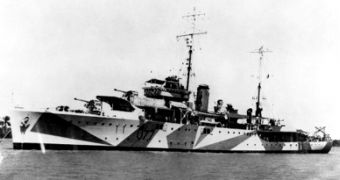A camouflage technique used during the two World Wars could make a comeback soon. Researchers at the University of Bristol have proven that dazzle camouflage functions, in the first-ever scientific study on the issue.
This approach to concealing warships and army vehicle was widely used in the two conflicts, and its main purpose was not to make the vehicles invisible, as one might expect, but rather to confuse the enemy into miscalculating its shots.
Dazzling camouflage implies painting ships and land vehicles with high-contrast geometric patterns. The colors and shapes make it more difficult for enemies to accurately calculate the speed, direction, and other parameters related to the vehicle.
Until now, there were no scientific evidence that this happened, only anecdotal proof. The Bristol team conducted the first study in history to look at dazzle camouflage, and found out that it works.
However, some restrictions do apply, the team says. For example, this type of camouflage works only when the vehicle using it is moving fast. In other words, ships using it during the World Wars might not have benefited that much from it.
But today's land vehicles could, the group explains. On battlefields across the world, fast-moving Humvees and other types of armored machines are delivering soldiers directly to the front lines.
Oftentimes, these personnel carriers come under attack from rocket-propelled grenades, which are launched from weapons that can be carried by a single individual. Distorting that individual's perception of the moving vehicle might save the lives of those inside.
The new study is the result of an interdisciplinary collaboration between experts at the Bristol Schools of Experimental Psychology and Biological Sciences. The team was led by Dr. Nick Scott-Samuel.
“The effect should obtain in predators launching ballistic attacks against rapidly moving prey, or on modern, low-tech battlefields where handheld weapons are fired from short ranges against moving vehicles,” he explains.
“In the latter case, we show that in a typical situation involving an RPG7 attack on a Land Rover the reduction in perceived speed would be sufficient to make the grenade miss where it was aimed by about a meter, which could be the difference between survival or otherwise for the occupants of the vehicle,” the expert says.
Details of the new study appear in a paper entitled “Dazzle camouflage affects speed perception,” which is opublished in the latest issue of the open-access, peer-reviewed journal PLoS One.

 14 DAY TRIAL //
14 DAY TRIAL //